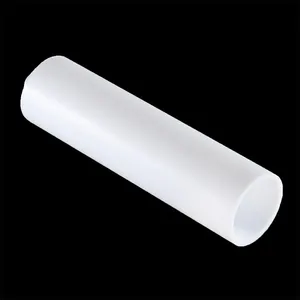Polytetrafluoroethylene (PTFE) sheets are incredibly versatile and have a wide range of applications, from gaskets to mousepads. Known for their non-stick properties and high resistance to temperature and chemicals, PTFE sheets are essential in various industries. This guide will walk you through the process of making PTFE sheets, exploring everything from the manufacturing process to tips on cutting and bending these sheets.
The process of making PTFE sheets involves several steps. PTFE is a synthetic fluoropolymer of tetrafluoroethylene, commonly known by the brand name Teflon. Here’s a breakdown of how PTFE sheets are manufactured:
Step 1: Polymerization
The manufacturing process begins with polymerization, where tetrafluoroethylene monomers are chemically bonded to form PTFE. This process typically takes place in a controlled environment to ensure the purity and consistency of the material.
Step 2: Molding
Once the PTFE is polymerized, it is molded into the desired shape. This involves compressing the PTFE powder into a mold under high pressure. The mold is designed to form sheets of a specific thickness and size, depending on the intended application.
Step 3: Sintering
After molding, the PTFE sheet is subjected to a sintering process. This involves heating the sheet at a high temperature but below its melting point, allowing the particles to bond without liquefying. Sintering enhances the mechanical properties of the PTFE sheet, giving it its characteristic strength and durability.
Step 4: Cooling and Finishing
Following sintering, the PTFE sheet is slowly cooled to maintain its structural integrity. Once cooled, the sheet is subjected to finishing processes, which may include surface treatment or cutting to size.
How to Make a PTFE Gasket

PTFE gaskets are widely used in industries requiring chemical resistance and high-temperature tolerance. Here’s how you can make a PTFE gasket:
Materials Needed
- PTFE sheet
- Gasket cutter or knife
- Measuring tools
Steps
- Measure and Mark: Determine the size and shape of the gasket you need. Use measuring tools to mark the dimensions on the PTFE sheet.
- Cut the Gasket: Using a gasket cutter or a sharp knife, carefully cut out the gasket shape from the PTFE sheet. Ensure the edges are smooth to prevent any sealing issues.
- Test the Fit: Before finalizing, test the gasket for fit within the intended application. Make any necessary adjustments for a perfect seal.
Cutting and Bending PTFE Sheets
How to Cut PTFE Sheets
Cutting PTFE sheets requires precision and the right tools to avoid damaging the material.
- Select the Right Tool: Use a sharp utility knife, rotary cutter, or a specialized PTFE cutting tool.
- Secure the Sheet: Lay the PTFE sheet on a stable surface to prevent movement during cutting.
- Cut with Care: Apply steady pressure and make slow, deliberate cuts to achieve a clean edge. For thicker sheets, multiple passes may be necessary.
How to Bend PTFE Sheets
Bending PTFE sheets is more challenging due to their high resistance to deformation.
- Heat the Sheet: Gently heat the area you wish to bend using a heat gun. Do not overheat, as this can damage the sheet.
- Apply Pressure: Once the PTFE is warm and pliable, apply even pressure to bend it to the desired angle.
- Cool in Position: Allow the bent sheet to cool in its new position to maintain the shape.
PTFE Sheet Mousepads and Reddit Insights
by Michael Schiffer (https://unsplash.com/@michael_schiffer_design)
PTFE sheets make excellent mousepads due to their smooth surface and durability. Here’s how you can create a custom PTFE mousepad:
Creating a PTFE Mousepad
- Select the Size: Determine the size of the mousepad based on your desk space and preferences.
- Cut to Size: Use the cutting techniques discussed earlier to cut the PTFE sheet to the desired dimensions.
- Add Backing: For added stability, you can attach a non-slip backing to the PTFE sheet using adhesive.
Insights from Reddit
Reddit communities provide a wealth of information on using PTFE sheets for various applications. For instance, users often discuss the benefits of PTFE mousepads in gaming setups, citing their smooth glide and durability as key advantages. Engaging with these communities can offer practical insights and tips from other PTFE enthusiasts.
Best Practices and Tips
Choosing the Right PTFE Sheet
When selecting a PTFE sheet, consider factors such as thickness, size, and intended application. For instance, thicker sheets may be more suitable for heavy-duty industrial applications, while thinner sheets can be ideal for smaller projects like gaskets or mousepads.
Maintenance and Care
To prolong the life of your PTFE products, clean them regularly with mild detergents and avoid abrasive materials that could scratch the surface. Proper storage away from direct sunlight and extreme temperatures will also help maintain their integrity.
Safety Precautions
When working with PTFE sheets, particularly during cutting and heating, take appropriate safety precautions. Wear protective gloves and eyewear, and ensure adequate ventilation to avoid inhaling any fumes generated during heating.
Conclusion
PTFE sheets are a versatile and valuable material with applications across various industries. Whether you’re manufacturing a PTFE gasket, creating a custom mousepad, or exploring other uses, understanding the manufacturing process and handling techniques will empower you to make the most of this exceptional material. With the right tools and knowledge, you can effectively cut, bend, and customize PTFE sheets to suit your needs.
By following this guide, you can explore the potential of PTFE sheets in your projects and discover why they are a go-to choice for many professionals. Happy crafting!







